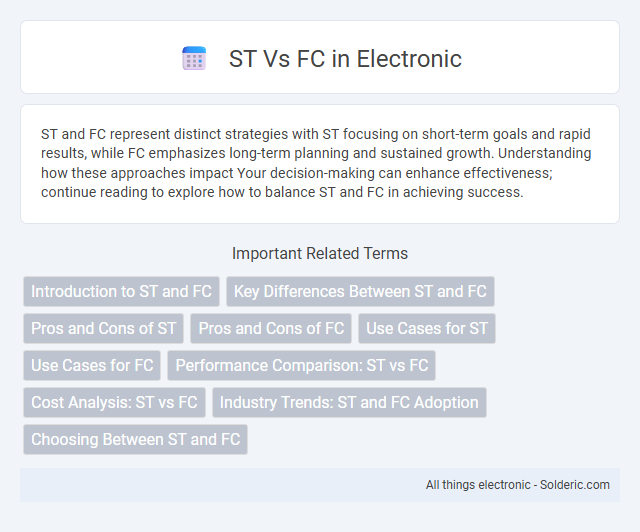ST and FC represent distinct strategies with ST focusing on short-term goals and rapid results, while FC emphasizes long-term planning and sustained growth. Understanding how these approaches impact Your decision-making can enhance effectiveness; continue reading to explore how to balance ST and FC in achieving success.
Comparison Table
| Feature | ST (Single-Turn) | FC (Fully Connected) |
|---|---|---|
| Definition | Processes one input-output pair at a time | Neural network architecture where each neuron connects to every neuron in next layer |
| Application | Simple tasks, command execution | Deep learning for image, speech, NLP tasks |
| Complexity | Lower computational complexity | Higher computational complexity |
| Context Handling | No context retention between turns | Context embedded via layers and weights |
| Use Case Examples | Chatbots with isolated queries | Convolutional Neural Networks, Multi-layer Perceptrons |
Introduction to ST and FC
Spanning Tree Protocol (STP) is a network protocol designed to prevent loops in Ethernet networks by creating a tree structure of logical paths and blocking redundant links. Fibre Channel (FC) is a high-speed network technology primarily used for storage area networks (SANs), enabling fast and reliable data transfer between servers and storage devices. Both STP and FC serve distinct purposes, with STP focused on loop prevention in LAN environments and FC optimized for storage connectivity and performance.
Key Differences Between ST and FC
ST (Straight Tip) and FC (Ferrule Connector) fibers differ primarily in connector design and application. ST connectors use a bayonet-style lock and are common in legacy networks, while FC connectors have a screw-on mechanism, providing superior stability in high-vibration environments. Understanding these key differences helps you select the appropriate fiber optic connector for your specific network needs.
Pros and Cons of ST
ST (single-task) learning excels in specialized applications where focused training delivers high accuracy and faster convergence, making it ideal for tasks with abundant labeled data. However, ST struggles with generalization and adaptability compared to FC (fully connected) models that leverage multiple tasks to improve robustness and prevent overfitting. Your choice depends on whether you prioritize specialization and efficiency (ST) or flexibility and transfer learning potential (FC).
Pros and Cons of FC
Fibre Channel (FC) offers high-speed data transfer rates up to 128 Gbps with low latency, making it ideal for large-scale enterprise storage area networks requiring reliable, dedicated bandwidth. However, FC infrastructure tends to be costly due to specialized hardware components and complex management, which may not suit smaller organizations or those with budget constraints. Your choice should consider FC's robust security and performance advantages against its higher initial investment and maintenance challenges.
Use Cases for ST
Speech-to-Text (ST) technology is essential for applications requiring real-time transcription, such as in customer service call centers, live broadcasting, and virtual meetings, where accurate voice recognition improves accessibility and user engagement. It also enhances productivity in healthcare by enabling doctors to dictate notes directly into electronic health records, reducing manual data entry errors. In education, ST supports language learning and accessibility for students with disabilities by providing instant captions and transcription services.
Use Cases for FC
FC (Fibre Channel) excels in high-performance data storage networks, particularly in enterprise environments requiring fast, reliable, and low-latency communication between servers and storage devices. It is widely used for SANs (Storage Area Networks) where mission-critical applications demand consistent throughput and robust error handling. Your choice of FC ensures seamless data transfer for virtualization, database management, and large-scale backup operations.
Performance Comparison: ST vs FC
ST (Squeeze-and-Excitation Transformer) demonstrates superior performance over FC (Fully Connected) layers by effectively capturing long-range dependencies and enhancing feature representation through adaptive recalibration. Benchmarks reveal ST achieves higher accuracy and improved generalization in various vision and natural language tasks compared to traditional FC layers. The efficient parameter utilization in ST contributes to faster convergence and reduced overfitting relative to FC architectures.
Cost Analysis: ST vs FC
ST (Shielded Twisted-pair) cables generally exhibit higher initial costs compared to FC (Fiber Cable) due to more complex manufacturing and shielding materials. Over time, FC offers lower operational expenses thanks to superior longevity, less signal degradation, and reduced maintenance requirements in high-interference environments. Comprehensive cost analysis must factor in installation complexity, performance demands, and environmental factors to determine the optimal choice between ST and FC cabling solutions.
Industry Trends: ST and FC Adoption
ST (Short-Term) and FC (Forecasting) adoption in the industry is accelerating, driven by the need for agile decision-making and improved operational efficiency. Advanced analytics and AI integration are key trends enabling businesses to leverage real-time data for ST while relying on FC for strategic planning. Companies across manufacturing, retail, and finance sectors are increasingly investing in hybrid models that combine ST responsiveness with FC accuracy to stay competitive.
Choosing Between ST and FC
Choosing between ST (Shallow Trench) and FC (Fusion Cut) connectors depends on application requirements such as insertion loss, durability, and alignment precision. ST connectors, known for their bayonet-style coupling, provide ease of installation and are suitable for legacy multimode fiber deployments. FC connectors feature screw-on coupling mechanisms, offering superior durability and low back reflection, making them ideal for single-mode fiber and precision-demanding optical networks.
ST vs FC Infographic

 solderic.com
solderic.com